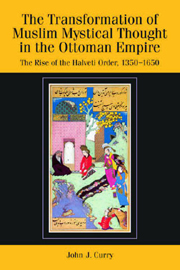 The Transformation of Muslim Mystical Thought in the Ottoman Empire
The Transformation of Muslim Mystical Thought in the Ottoman Empire from PART III - DEFENDING THE CULT OF SAINTS IN ELEVENTH/SEVENTEENTH-CENTURY KASTAMONU: TRANSFORMING THE ŞAcBÂNİYE ORDER UNDER cÖMER EL-FUɔÂDÎ
Published online by Cambridge University Press: 12 September 2012
The final years of cÖmer el-Fuɔâdî's life were marked by religious and political tensions in the Ottoman Empire present since the time of its foundation, and his contemporaries came to note him as a central figure in the debates that caused those tensions. Therefore, to a great extent, any assessment of his life and legacy must be grounded in the context of his polemical response to the religio-political crisis revolving around Muslim mysticism. The crisis was best symbolized by the intractable debate over the legitimacy of the Halveti semâc, chanted litanies set to musical accompaniment, and devrân, the circular motions that went with it that sought to bring the seekers into a mystical state. The debate over these practices had ancient roots, but had usually not taken on the form of a lengthy and sustained campaign against them. But by Fuɔâdî's time, the level of aggression and hostility over the issue had risen significantly.
To a modern observer the debate appears quaint or eccentric. Some might liken it to the Byzantine debate over Iconoclasm, sometimes interpreted as an obscure doctrinal dispute that had little relevance to the Byzantine Empire's very real problems in staving off Arab and Bulgarian invasion. Nevertheless, a closer examination of the underlying issues suggests that there was more to the semâc/devrân conflict than hair-splitting clashes between theologians and mystics. Instead, the very foundations of Ottoman religious law was at stake.
To save this book to your Kindle, first ensure [email protected] is added to your Approved Personal Document E-mail List under your Personal Document Settings on the Manage Your Content and Devices page of your Amazon account. Then enter the ‘name’ part of your Kindle email address below. Find out more about saving to your Kindle.
Note you can select to save to either the @free.kindle.com or @kindle.com variations. ‘@free.kindle.com’ emails are free but can only be saved to your device when it is connected to wi-fi. ‘@kindle.com’ emails can be delivered even when you are not connected to wi-fi, but note that service fees apply.
Find out more about the Kindle Personal Document Service.
To save content items to your account, please confirm that you agree to abide by our usage policies. If this is the first time you use this feature, you will be asked to authorise Cambridge Core to connect with your account. Find out more about saving content to Dropbox.
To save content items to your account, please confirm that you agree to abide by our usage policies. If this is the first time you use this feature, you will be asked to authorise Cambridge Core to connect with your account. Find out more about saving content to Google Drive.